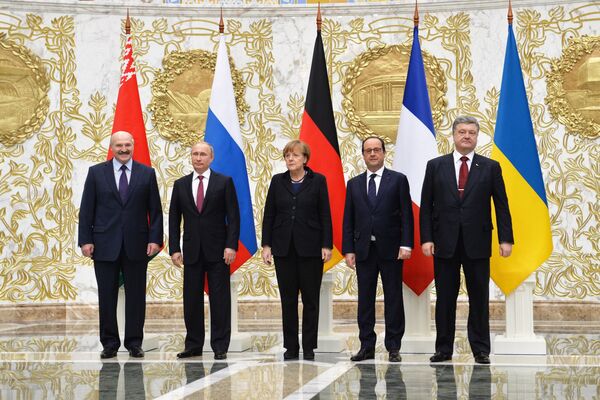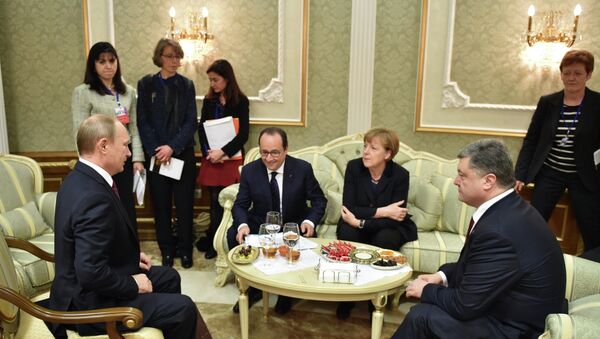The venue for the February 11 Normandy Four meeting remained the same as in September of last year: the vast marble-and-glass Independence Palace in the Belarusian capital, Minsk. The room for negotiations, however, was shifted from a spacious hall with a large table to the “Green Room” proposed by President Putin. The room features a low coffee table in the middle, which is impossible to bend towards and absolutely ill-fitted for 16-hour-long negotiations.
While the extended negotiations with other members of the delegations were held in a larger room, the four heads of states stuck to the Green one.
The room was furnished with a soft sofa and two armchairs from the same set, which were taken by Presidents Hollande and Poroshenko and Chancellor Merkel.
President Putin, however, opted for a chair from another set – a hard one, with a straight back.

While it made no difference to the majority of the viewers, some reporters had unique insights on the whole matter.
As it turned out, a similar issue had been described long ago by the well-known Russian diplomat Ivan Maisky (the USSR's ambassador to the UK during much of World War Two) in his Memoirs of a Soviet Ambassador: The War 1939-43, according to lawyer and blogger Tatyana Volkova.
“Simon (Sir John Simon, British politician) invited me to take a seat in an arm-chair by the writing table. I sat and sank down into some bottomless softness. I hate overly 'comfortable' armchairs, as they are purposefully designed to soften brains and benumb sensuous alertness,” the blogger quotes him as saying.
Parallels have been drawn to Putin's attitude at the high-profile meeting in Minsk. It remains to be seen who was able to walk away from the debate with a better deal, but President Putin was very fresh and joyful after the talks.

Another question which has been raised by the journalists was if there was any unifying principle behind the order that the participating country's national flags were placed in. They clearly weren't in alphabetical order; what then?
The host of the meeting, Belarussian President Lukashenko, offered his explanations of the protocol riddle. “The idea is simple and let me explain right away,” he said in an interview with journalist Sergei Brilyov in the latter's Rossiya 1 TV show “Vesti on Saturday”.
“There was one woman between us and two presidents – the main people. Me and Petro (Poroshenko) are not that important,” he joked.

Thus the German national flag was in the middle, the Russian and French flags were on each side, and the Belarussian and Ukrainian flags were at the far ends. The Belarussian flag, however, was put next to Russia’s. “We are friends,” he explained.
“When we stood for a family photo, I asked Putin if it was that big of a deal (putting our flags next to each others'),” Lukashenko said. “He answered: it is absolutely right.”
While asking President Lukashenko of his impressions of President Hollande and Chancellor Merkel, Sergei Brilyov mentioned an interesting fact: the last German head of state to visit Belarus was Adolf Hitler in 1942. The last French leader was Napoleon, in 1812. And then there was a long-lasting break in bilateral relations.
However, President Lukashenko said that quite unexpectedly, President Hollande had turned out to be a “kind soul” – a very interesting, kind, communicative, but very cautious man.
Describing Chancellor Merkel, President Lukashenko noted that her “humaneness” prevailed over other qualities.
Everyone involved conveniently forgot that not long ago, Belarus was considered a rogue state and was sanctioned by the West.

